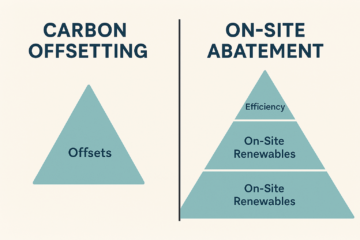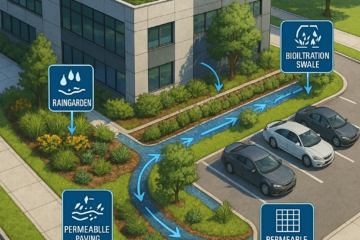Why Conversions Are Booming in 2025
CBD office vacancies are hovering around 14 %, while Australia’s housing shortfall exceeds 175,000 dwellings. Converting surplus office stock into apartments can be 20–40 % faster than new builds and saves up to 65 % of upfront embodied carbon—but only if you nail the ESD fundamentals.
Regulatory Snapshot
- Change of Class: BCA Class 5 → Class 2 triggers full NCC residential provisions, including NatHERS 7‑Star thermal comfort.
- Green Star Buildings v1.1: Up to 9 points for adaptive‑reuse and upfront‑carbon reduction.
- Local Planning: Councils often require daylight & natural‑ventilation studies for deep floor plates.
Top ESD Pitfalls (and How to Avoid Them)
| Pitfall | Impact | Fix |
| Glazing Ratios > 70 % | Overheating & heat loss; hard to hit NatHERS | Add high‑performance secondary glazing (Uw ≤ 2.0, SHGC 0.3) or introduce insulated spandrels |
| Deep Floor Plates | Poor daylight & cross‑ventilation | Carve light wells / atriums; use mirrored light‑shelves & mixed‑mode HVAC |
| Thermal Bridging in Steel Frame | Condensation & energy penalty | Apply external insulation wrap; use thermally broken window brackets |
| Legacy HVAC | Oversized, inefficient, no individual control | Replace with VRF heat‑pump pods per floor; add HRV units in each apartment |
| Acoustic vs Thermal Conflict | Double‑glazing adds mass but reduces operability | Use acoustic ventilators with 45 dB RW + trickle vents for fresh air |
| Limited Roof Area | PV & HW sizing constraints | Deploy building‑integrated PV on façades & prefab balcony balustrades |
Performance Hacks That Pay Back
- Embodied‑Carbon Reuse Credits – Retain > 60 % of structure to claim Green Star Adaptive Reuse points and cut upfront CO₂ by ~800 kg/m².
- Hybrid Ventilation – Pair operable windows with decentralised HRV units to meet NatHERS ventilation hours and improve IAQ.
- Modular Bathroom Pods – Reduce construction waste by 30 % and speed programme by four weeks.
- Phase‑Change Ceiling Panels – Shave peak cooling loads by 15 % in west‑facing units (see Post 5).
- Smart Metering per Apartment – Enables NABERS for Apartments certification, adding 2–3 % asset value.
Cost‑Benefit Snapshot
| Upgrade | CapEx Premium (AU$/m²) | Annual Energy Savings | Simple Payback |
| Secondary Glazing | 95 | 18 kWh/m² | 6.5 yrs |
| VRF Heat‑Pump System | 110 | 23 kWh/m² | 7 yrs |
| HRV Units | 60 | 9 kWh/m² + IAQ | 8 yrs |
| Roof & Façade BIPV (20 kW) | 2,800/m² roof | 28 MWh/yr | 9–11 yrs |
Mini Case Study – “The Switch”, Adelaide
A 1980s office tower (15,000 m² NLA) was converted into 312 student apartments in 2024:
- Kept 92 % of structure → 10,400 t CO₂e saved upfront.
- Achieved NatHERS average 7.4 stars via secondary glazing + light wells.
- Added 100 kW of façade BIPV, covering 25 % of common‑area loads.
- Project IRR improved from 11 % (new build) to 15 % thanks to reduced programme and carbon credits.
Action Checklist for Your Project
- Run a Daylight & NatHERS feasibility at concept stage.
- Engage ESD & structural engineers early to lock in reuse scope.
- Model thermal bridging in THERM or Revit Insight.
- Validate acoustic + ventilation with CFD / noise maps.
- Document embodied‑carbon savings for Green Star submission.




0 Comments